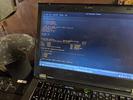Work.
Later tonight we should see results from MARSIS. It starts scanning today! We will also see the Deep Impact mission come to a head.
Scientists have discovered that when radio frequencies are projected at space dust clouds they produce Masers. Masers are Lasers with radio wavelengths. The Maser is also amplified by 5%. They theorise this phenomena could provide a handy way to amplify deep space transmissions for communication in the future. Very cool. The way they worked all this out was to watch a neutron star or pulsar called B1641-45. Pulsars emit powerful beams of radio waves from their poles. Because pulsars are always rotating, they appear to sweep around like a lighthouse beams. They observed the beam entering the cloud and also observed the maser 'output' of the cloud. They did this using a radio telescope in Parkes. Cool. Aussie Scientists discover it first again!
Work has started in the mirror lab at Steward Observatory to produce six 8.4m concave mirrors and one 8.4m 'doughnut' mirror for a new telescope in Chile. This is a massive project that will probably take 10 years to complete. They calculate this telescope will have 10 times the resolving power of Hubble and will be more powerful than any other telescope in the world. This type of telescope is called an "off axis" telescope. Mirrors are placed around the axis in a petal arrangement. In the centre is a doughnut mirror. The petals pick up the light, the light is bounced off smaller petals that are placed out on an arm. The light is reflected from the small petals to the doughnut. The doughnut reflects the light to a central mirror in the middle of the axis and in the middle of the small petals. this project is called Giant Magellan Telescope or GMT.
 |
| An Off Axis (Magellan) Telescope |











